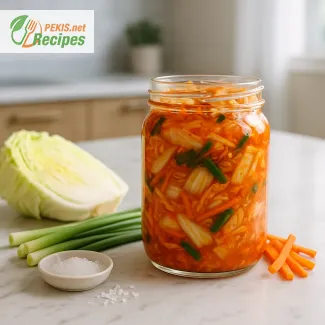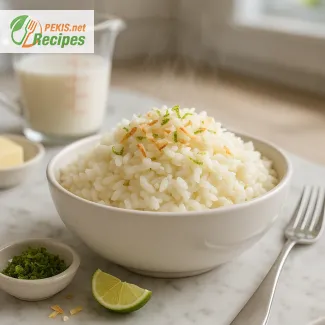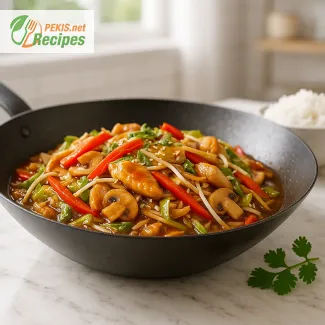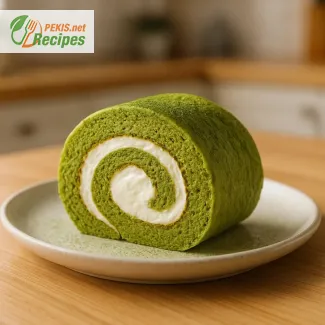Authentic Thai Pad Thai serves 4, with 20 minutes prep, 15 minutes cooking, and ready in just 35 minutes. Made with chewy rice noodles, tender shrimp, savory chicken, and crispy tofu, all coated in a tangy tamarind sauce and finished with crunchy peanuts and fresh lime. The result is a perfectly balanced dish of sweet, sour, salty, and spicy flavors that feels both light and satisfying. Best enjoyed fresh, but it keeps up to 2 days refrigerated or 2 months frozen, making it a versatile choice for both quick weeknight dinners and advance meal prep.
PEKIS – professional chef and recipe developer with more than 25 years of experience, specialized in European and international cuisine. I’ve worked with countless Asian stir-fry dishes, but Pad Thai remains one of the most rewarding to share. Over the years, I’ve refined the balance of tamarind, palm sugar, and fish sauce to bring out the authentic taste you’d expect from a street stall in Bangkok, while still keeping it simple enough for any home kitchen.
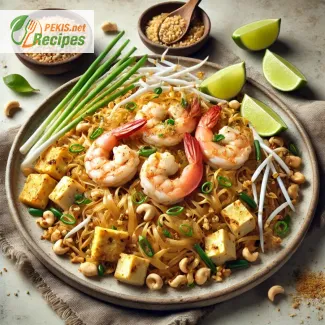
Exploring the Essence of Authentic Thai Pad Thai
A timeless balance of flavors and textures
Few dishes capture the heart of Thai cuisine as completely as Pad Thai, a harmonious combination of rice noodles, crisp vegetables, tender proteins, and the unmistakable play of sweet, sour, salty, and umami notes. The dish is both comforting and refreshing, making it one of the most popular Asian stir-fry recipes across the globe. Each bite delivers contrast: chewy noodles coated in a glossy sauce, the crunch of peanuts, the zing of lime, and the subtle heat of chili.
Pad Thai is often described as the perfect representation of street food culture in Thailand, where it has been enjoyed for generations at bustling night markets, small roadside stalls, and family kitchens. What makes it truly special is its adaptability: it can be prepared with shrimp, chicken, tofu, or a mix of seasonal vegetables, while the foundation always remains the delicate stir-fried noodles kissed by tamarind-based sauce.
The cultural story behind Pad Thai
Although it feels ancient, the roots of Pad Thai are relatively modern. It rose to prominence in the 1930s and 1940s as part of a cultural identity movement in Thailand, encouraged by the government to popularize rice noodles instead of rice. This initiative not only strengthened a national dish but also symbolized unity and resilience during times of change. Today, Pad Thai continues to be a dish that connects people to Thai heritage while adapting effortlessly to contemporary kitchens around the world.
Why this dish remains a favorite
- Balanced flavors: Sweet, sour, salty, and spicy create a multidimensional taste.
- Versatile proteins: Works equally well with shrimp, chicken, tofu, or vegetables.
- Quick preparation: From stove to plate in under 30 minutes.
- Nutritious variety: Combines noodles, vegetables, protein, and garnishes in one dish.
- Global appeal: Recognizable and loved in restaurants and homes worldwide.
Key elements that define Pad Thai
- Rice noodles: Wide and flat, they soak up sauces while maintaining a chewy texture.
- Tamarind paste: Brings a signature tanginess, different from citrus acidity.
- Palm sugar: Provides a subtle caramel sweetness, balancing sour notes.
- Fish sauce or soy sauce: Adds depth and savory richness.
- Fresh herbs and lime: Brighten the final dish and cut through richness.
- Crushed peanuts: Deliver crunch and a nutty finish.
Storing and making ahead
Proper storage helps maintain flavor and texture:
- At room temperature: Safe for up to 2 hours after cooking.
- In the refrigerator: Keeps well for 2 days in an airtight container.
- Freezing: Up to 2 months; best to freeze noodles and sauce separately for better texture.
- Reheating: Warm in a skillet over medium heat or in the oven at 150 °C (300 °F) for 8–10 minutes until evenly heated.
Creative variations worth trying
- Spicy Pad Thai: Add extra chili flakes or fresh Thai chilies for bold heat.
- Vegetarian Pad Thai: Replace fish sauce with soy sauce and use tofu as the main protein.
- Seafood Pad Thai: Mix shrimp, squid, and scallops for a luxurious twist.
- Green Pad Thai: Incorporate spinach noodles and fresh basil for a modern, vibrant touch.
- Nut-free Pad Thai: Swap peanuts for toasted sesame seeds or pumpkin seeds.
Why you will love making it at home
- Easy to personalize with seasonal produce and your choice of protein.
- Perfect balance of flavors without complicated techniques.
- A single-pan dish that minimizes cleanup.
- Brings authentic Thai flavors directly to your table.
- Flexible enough for weeknight dinners or special gatherings.
Beyond the plate
Pad Thai has become more than a recipe—it is a cultural bridge that brings people closer to Thai traditions while allowing infinite creativity in home kitchens. Whether prepared in a street stall in Bangkok or a family kitchen abroad, it embodies the idea that simple ingredients, when balanced thoughtfully, can create extraordinary results. Each serving tells a story of history, identity, and flavor that resonates far beyond the borders of Thailand.
- Soak the rice noodles in warm water for 20–25 minutes until pliable, then drain.
- Heat vegetable oil in a wok or large skillet over medium-high heat.
- Add garlic and stir-fry for 30 seconds until fragrant.
- Add chicken and shrimp, cook until just done, then add tofu cubes.
- Push ingredients to one side, crack eggs into the wok, scramble lightly, and mix through.
- Add soaked noodles, tamarind paste, palm sugar, fish sauce, and soy sauce. Stir-fry until noodles are coated and tender.
- Add bean sprouts and green onions, toss briefly to keep them crisp.
- Remove from heat, drizzle with lime juice, sprinkle with crushed peanuts and chili flakes.
- Serve immediately, garnished with additional lime wedges and fresh herbs if desired.
FAQ questionWhat makes an authentic Pad Thai sauce?
A classic Pad Thai sauce balances tamarind paste (tangy), palm sugar (caramel sweetness), and fish sauce (salty umami depth). Some cooks round it out with a touch of soy sauce for color and lime for brightness. The key is balance: the sauce should taste slightly tangy first, then sweet, then savory—so it clings to rice noodles without being syrupy.
FAQ questionHow do I keep rice noodles from turning mushy or clumping?
Use soaking, not boiling. Soak flat rice noodles in warm water until just pliable, then drain well. Stir-fry over high heat with enough sauce to coat but not drown the noodles, and avoid overcrowding the pan—work in small batches. Toss constantly and finish as soon as the noodles turn glossy and tender. A light drizzle of oil before they hit the wok can reduce sticking.
FAQ questionCan I make Pad Thai without fish sauce (gluten-free or vegan)?
Yes. For vegan Pad Thai, swap fish sauce with gluten-free soy sauce (tamari) or coconut aminos, plus a splash of mushroom seasoning for umami. Keep tamarind paste and palm sugar to preserve the signature sweet-sour profile. To stay gluten-free, ensure your soy/tamari is certified gluten-free and use rice noodles (naturally gluten-free).
FAQ questionWhich protein works best, and when should I add it?
Shrimp, chicken thigh, and firm tofu are all traditional. Sear the protein first over high heat until just cooked, remove it, then stir-fry noodles and sauce. Return the protein at the end with bean sprouts and scallions so nothing overcooks. For tofu, press and pan-fry until golden to keep cubes crisp in the final dish.
FAQ questionDo I need a wok, or will a skillet work?
A carbon-steel wok excels at fast, even heat and quick tossing, enhancing that faint smoky stir-fry aroma. A heavy 12-inch skillet also works—preheat it thoroughly, cook in smaller batches, and keep ingredients moving. The essentials aren’t the vessel alone but high heat, dry, hot pan, and speed.
FAQ questionWhat garnishes and add-ins are essential for the right finish?
Top with crushed peanuts, lime wedges, fresh garlic chives or scallions, a handful of bean sprouts, and chili flakes for adjustable heat. Optional but popular add-ins include pickled radish for gentle funk and a touch of dried shrimp for extra umami. Garnishes should bring crunch, freshness, and acidity to balance saucy noodles.
FAQ questionHow long does Pad Thai keep, and how should I reheat it?
Best fresh, but it keeps up to 2 days refrigerated in an airtight container. For longer storage, freeze up to 2 months (noodles and sauce freeze well; add fresh sprouts and herbs after reheating). Reheat in a hot skillet with a splash of water to loosen the sauce or warm in the oven at 150 °C (300 °F) for 8–10 minutes until hot and glossy.
Authentic Thai Pad Thai stands as one of the most recognizable and beloved dishes from Southeast Asia, a recipe that blends rice noodles, tamarind, palm sugar, and fish sauce into a perfectly balanced meal. With its vibrant mix of sweet, sour, salty, and spicy elements, it delivers a harmony of taste and texture that appeals to nearly every palate. Adding proteins such as shrimp, chicken, or tofu makes it versatile enough for weeknight cooking or festive gatherings.
Beyond flavor, this dish carries cultural value. Born from Thailand’s national movement to highlight noodle-based meals, it became an icon of Thai street food and global dining. Preparing it at home not only recreates the experience of bustling Bangkok markets but also ensures a dish that is fresher and adaptable to personal taste.
Cooking Pad Thai invites creativity. Adjust the heat level with chili, swap proteins, or keep it vegetarian by leaning on tofu and fresh vegetables. The result is always a plate filled with color, aroma, and the unmistakable essence of Thai cuisine. Its adaptability ensures it remains a go-to recipe across generations.
Equally important is the ease of storage and preparation. It can be made ahead, stored in the fridge for two days, or frozen for up to two months, retaining its balance of flavors when reheated. This practicality, combined with its rich history and culinary appeal, secures Pad Thai’s place as a dish that connects tradition, convenience, and timeless flavor.
Every serving carries both authenticity and flexibility, making it more than a recipe—it is an expression of Thai culinary heritage shaped into a meal that continues to inspire kitchens around the world.
Allergens present in the recipe:
- Peanuts
- Soy
- Fish sauce (fish)
- Eggs
- Gluten (if soy sauce used is not gluten-free)
Substitution tips to avoid allergens and gluten:
- Replace peanuts with toasted pumpkin seeds or sunflower seeds.
- Replace fish sauce with a gluten-free soy sauce or coconut aminos for a vegan option.
- Use gluten-free soy sauce or tamari to eliminate gluten.
- Omit eggs and add more tofu or vegetables for an egg-free version.
- Vitamin A: 320 µg – supports vision and immune function.
- Vitamin C: 18 mg – boosts immunity and aids collagen production.
- Vitamin K: 45 µg – supports bone health and blood clotting.
- Folate (B9): 60 µg – essential for cell growth and DNA synthesis.
- Calcium: 90 mg – important for bones and teeth.
- Iron: 3.2 mg – supports red blood cell formation and oxygen transport.
- Magnesium: 45 mg – regulates muscle and nerve function.
- Potassium: 410 mg – essential for heart health and fluid balance.
- Lycopene (from chili) 1.2 mg – reduces oxidative stress and supports heart health.
- Flavonoids (from peanuts and bean sprouts) 20 mg – anti-inflammatory and protective against chronic disease.
- Vitamin E (from vegetable oil and peanuts) 2.5 mg – protects cells from damage.
- Beta-carotene (from green onions) 1.1 mg – supports skin and eye health.
